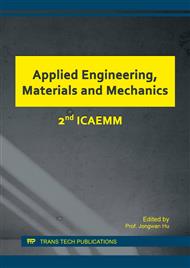[1]
H. C. Fang. Design of the heave compensation device for offshore drilling vessel. Oil Field Equip. 5 (1976) 25-37.
Google Scholar
[2]
Q. Xu, P. A. Abbott, J. Halkard. Heave suppressed offshore drilling and production platform and method of installation: U.S.A. 6652192 (2003) 11-25.
Google Scholar
[3]
G. Sarker, G. Myers, T. Williams. Comparison of heave motion compensation systems on scientific ocean drilling ship and their effects on wire line logging data. Offshore Technology Conference Houston, Texas, U.S.A., OTC (2006) 17916.
DOI: 10.4043/17916-ms
Google Scholar
[4]
Z. B. Chen, Y. Lv, Z. G. Li. Review of drilling string heave compensation systems for floating drilling platform. Oil Field Equip. 40 (2011) 28-32.
Google Scholar
[5]
L. M. Huang, Y. T. Zhang, L. Zhang. Semi-active drilling drawworks heave compensation system. Petrol. Explorat. Dev. 40 (2013) 665-670.
DOI: 10.1016/s1876-3804(13)60089-0
Google Scholar
[6]
Y. T. Zhang, Z. D. Liu, H. Jiang. Study on Active Force of Compensation System for Floating Drilling Platform. Oil Field Equip. 39 (2010) 1-4.
Google Scholar
[7]
H. T. Zhao, Y. F. Qu, D. Wang. The key research and design of hook block assembly heave compensator. Mech. Eng. (2012) 62-64.
Google Scholar
[8]
Y. F. Qu. Research on key technology of composite cylinder type crown-block heave compensation. China University of Petrol. (2012) 8-13.
Google Scholar
[9]
S. Lei, Q. J. Yue, W. S. Zhang. Heave motion analysis of a new-style floater based on semi-physical simulation. Acta Petrol. Sin. 33 (2012) 315-318.
Google Scholar
[10]
H. Jiang, Y. C. Liu, Y. T. Zhang. Design for an active drill-string heave compensation system of the float drilling Platform. Acta Petrol. Sin. 33 (2012) 483-484.
Google Scholar
[11]
R. H. Chen, J. J. Shen. Design and Calculation of Drilling Machine. BeiJing, (1995).
Google Scholar
[12]
Y. T. Zhang, Y. F. Qu, Z. D. Liu. Design of swing device for crown-block heave compensation system. J. Zhejiang University (Eng. Sci. ), 46 (2012) 2268-2273.
Google Scholar
[13]
T. Xu, Q. Y. Liu, X. M. Wang. Design of the new crown-block Heave compensation device, Mach. Des. Res. 31 (2015) 124-127.
Google Scholar
[14]
Y. F. Qu, Y. T. Zhang, J. T. Ma. Numerical simulation of the crown-block heave compensation device, Min. Metall. 22 (2013) 105-109.
Google Scholar
[15]
Y. S. Chen, B. Wu, Z. Wang, et al. Simulation and validation of a hybrid testing system with simulink. J. Vib. Shock. 33 (2014) 18-23.
Google Scholar
[16]
L. M. Huang, Y. T. Zhang, M. Y. Liu. Design for a drawworks heave compensation system of floating drilling platform. Acta Petrol. Sin. 34 (2013) 569-573.
Google Scholar
[17]
K. Sebastian, M. Tobias, N. J¨org. Active control for an offshore crane using prediction of the vessel's motion. H IEEE/ASME Trans. Mech. 16 (2011) 298-308.
Google Scholar


